There you are, minding your business as you lay on the couch with a book. Maybe you heard the approach of canine paws, maybe you didn’t. Suddenly, without warning, you feel the press of wet doggie tongue over your face. You’re the recipient of a puppy kiss. When you look up, your dog happily continues to lick your face. And you can’t help but laugh. But you might wonder what drives the urge behind dogs licking people. Are they the affectionate doggie kisses we often describe them as? That sounds sweet, of course. But what if there’s more to it? Let’s take a look behind the slobber and investigate why dogs lick people.
Dog Mouths
Before we get into the “Why” of dogs licking people, let’s confront the elephant in the room. Not everyone likes having their face licked (I’m one of them). Plenty of germaphobes out there prefer to jerk their heads back and avoid doggie tongues. And they have a good reason. The Old Wives Tale that a dog’s mouth is cleaner than yours? Yeah, not true.
Dogs carry PLENTY of bacteria in their mouths. They need them to break down their food and keep their teeth healthy. Unfortunately, those microbes don’t play nicely with OUR immune systems. And if you’ve ever ended up with a dog bite, you know that first-hand. Doctors clean and flush the wound to prevent infection. One little bug in particular can cause a lot of problems. Capnocytophaga canimorsus lives in dog saliva. It doesn’t affect canines, but humans? We don’t get along if we have certain compromising conditions. And if it squirms into an open wound, it can cause you to get sick, especially if your immune system isn’t functioning at peak performance.
But, in general? Dogs licking people doesn’t bother most owners – germs and all.
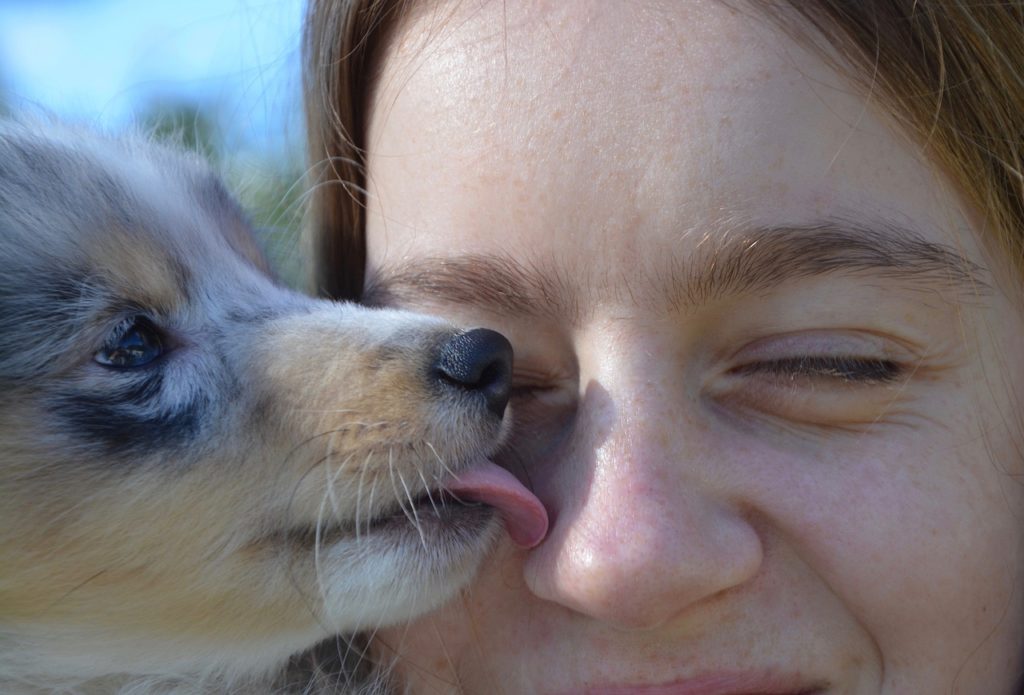
Dogs Licking People: What Does it Mean?
Quiz most dog-lovers, and they’ll assure you dogs licking people means affection. Why else call them doggie kisses? And we encourage that image by teaching our dogs to “kiss” us on the face. It’s often one of the best parts of the day, when we first come home or when we’re snuggling on the couch at the end of the day. That’s a private moment shared between our four-legged friend and ourselves.
But while you invested plenty of time working on reinforcing the behavior, it may NOT represent affection. There are plenty of other reasons behind the behavior of dogs licking people. And some of them? They might surprise you (or convince you that us germaphobes have the right idea).
Dogs Licking People: “More Please”
Unless you’re a breeder or watch animal programs regularly, you may miss one of the earliest puppy behaviors. True, puppies nurse from their mothers. But once they progress to more solid foods, they develop a new tradition. They start licking their mother’s mouth to encourage her to regurgitate pre-chewed food for them to eat. (Nope, not just a bird thing)
“Researchers of wild canids – wolves, coyotes, foxes, and other wild dogs – report that puppies lick the face and muzzle of their mother when she returns from a hunt to her den in order to get her to regurgitate for them.”
~Alexandra Horowitz, Author of Inside of a Dog: What Dogs See, Smell, and Know
So dogs licking people CAN represent a throw-back to that infantile behavior. If you recently finished eating, and your dog comes up to clean your face, they may be asking for some of your “leftovers.” Remember, dogs have an incredible sense of smell. Even if you swiped your face with a napkin (or a damp cloth), your pup could pick up the scent of your meal. And that means they’re looking for a handout. Even if they’re no longer a puppy needing mom’s assistance. Our domestication process often prompts dogs to continue puppy behaviors into adulthood, including dogs licking people for food.
Add in that our skin is naturally salty, and we’re delicious to dogs. If you recently exercised, that salt content goes up. And since you need to refuel after a hefty workout that means salt AND a snack! (Bet you didn’t consider that when you thought about dogs licking people!)
Dogs Licking People: Mother Knows Best
When mother dogs – or any canid, really – give birth, the first thing they do is clean the puppy’s face. This clears the nostrils so they can breathe and stimulates blood flow to the head. It’s the first bonding experience the two share. Depending on the species, other pack members may also lick the new puppy to welcome it to the family. It’s a natural grooming process that establishes affection between everyone – before eyes or ears open.
So, yes, dogs licking people CAN represent affection – though in a different way than most owners think. Humans replaced the canine members of the pack. The licking behavior remained, and they reaffirm those bonds when they “groom” us. It’s keeping everyone close and defined. This is why you often see your dog licking you and other family members but not necessarily strangers. As you bring in friends for regular visits, your dog may start to include them in the ritual as they recognize them as part of the “group.” But a person they happen to meet on a walk or run? The odds are you won’t see your dog licking that person.
Dogs Licking People: The Healing Touch
Affection is the first thought in most people’s minds when they see dogs licking people. And the majority of the time, there’s plenty of excitement and energy involved in the process – for both the canine and the human. But what about the times when you’ve noticed a dog approaching someone who ISN’T in the best mood? Maybe the pup doesn’t lick that person’s face, but they may grace their tongue over a hand or even leg. What’s going on there?
As with any animal, dogs pick up on emotions. They understand when we’re upset, nervous, or stressed. And, in the wild, licking is used to communicate submission as well as affection. The process of licking releases endorphins in your dog’s brain. Endorphins lower stress levels in the body, boosting a sense of well-being.
So when a dog feels someone in the house getting upset, they try to remedy the situation. Dogs licking people is their answer to diffusing the tension. This can be, so THEY feel better, or as a way to try to heal the human. They KNOW licking makes their brain calm down, so they assume the same is true for us. It’s affection, but with a twist. This is why you may notice your dog coming over when you feel down. Maybe they don’t jump up and slather your face with doggie kisses. Instead, they provide calm, quiet licks to the back of your hand. The love is still there, but it’s an attempt to improve YOUR mood.
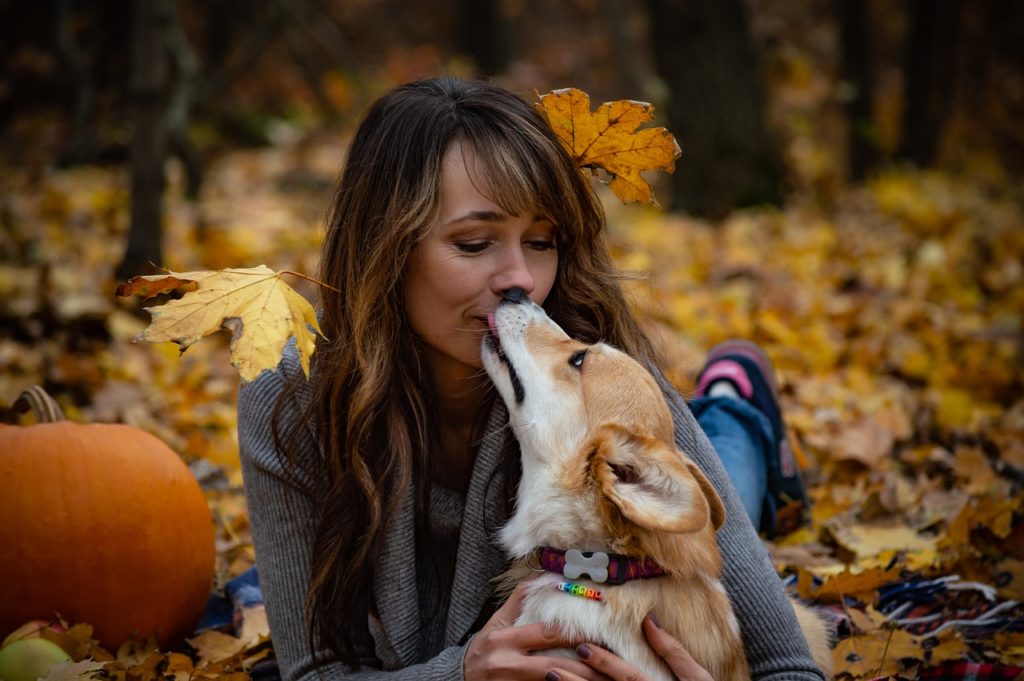
“No Licking Please”
Not everyone appreciates dogs licking people. In our house, there’s a firm “no face licking” rule. And our Greyhound knows and respects that rule (most of the time – she DOES get super-interested when either of us finishes a workout). But what do you do if your pup insists on licking you and you’re not comfortable? Can you stop the licking behavior? Perhaps not, but you CAN deflect it from YOU.
As usual, when you’re confronted with a behavior, you want to fade away, ignoring it is your best course of action. You don’t need to say “No” or make any motions that might frighten or startle your dog. Calmly get up (removing your face from the tongue zone) and go into another room. If you find yourself pursued, calmly close the door. As soon as your dog stops trying to lick you, praise them and offer a treat. Don’t go overboard, though, or you’ll stimulate them into doggie kissing mode again. If you stay firm in this routine, the behavior will naturally fade.
You can also redirect your dog to something that takes their attention away. If they’re playing with a puzzle toy or chasing a frisbee, they can’t lick. There’s no punishment involved OR negative reinforcement. You’re simply distracting your dog from licking people. And the same fading will occur.
Suppose you want a trained response of dogs licking people. You choose an assigned command. Then your dog will learn WHEN to give kisses. That may help if you have friends that aren’t comfortable getting licked. And you can work to have your dog lick a hand, cheek, or chin – versus your entire face. It’s a nice compromise.
Doggie Kisses
“Dogs often lick people to show affection, as a greeting, or to simply get our attention. Of course, if you happen to have a little food, lotion, or salty sweat on your skin, that may play a role, as well,” says Dr. Jennifer Coates, Pet Life Today Advisor. This pretty much sums up all of the possibilities behind dogs licking people. Does that mean you’re wrong when you call them doggie kisses? Of course not. But your dog may have more in mind when they stretch out their tongue.
And as long as everyone’s washing their hands and face, there’s no problem with the behavior.


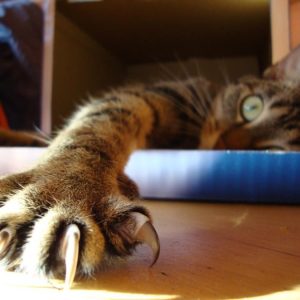
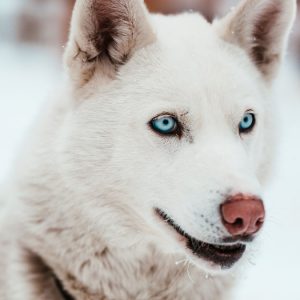


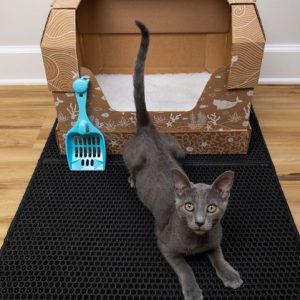




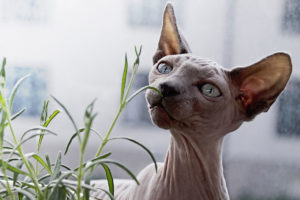

No comment yet, add your voice below!